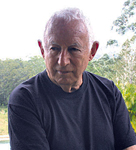
Click an Image below to Enlarge

Lawrence Daws (born 1927) is a Queensland based artist. He studied engineering and architecture at the University of Adelaide before coming to Melbourne to study at the Melbourne National Art School from 1950-1953. Daws first attracted serious critical attention when he co-exhibited with Donald Laycock, Clifton Pugh and John Howley at the Victorian Artists Society gallery in Melbourne in 1955.
From 1958 to 1959 Daws lived and worked in Rome before moving to London in 1960, where he lived for the next ten years. During this period he travelled extensively throughout Europe, Russia, India, Mexico and the U.S.A.. Returning to Australia in 1970, Daws lived on Bribie Island, Queensland for four years where he became friends with Ian Fairweather (Australia's most reclusive artist). In 1974 he moved to Owl Creek Farm in the Glasshouse Mountains of Queensland’s Sunshine Coast which has been his home base for most of his life since.
Daws’ earlier works were, in keeping with his background in engineering and architecture, concerned with the division of space and volume manifested in a formal language of semi-abstract expressionist painting. His works became more romantic/realist and atmospheric during the seventies when he started on his "Glasshouse Mountain" series for which he won much fame.
Daws has enjoyed a stellar professional career as a painter, having been selected to participate in the Whitechapel and Tate Gallery exhibitions of Australian Art,1961-62 and also representing Australia, alongside Charles Blackman and Brett Whiteley, at the Second Biennale des Jeunes, Paris in 1962. He has won the Dunlop Prize twice (1953 and 1954), the Italian Scholarship in 1957; International award, Biennale des Jeunes, Paris, 1962; Silver medal in the Bienal de San Paolo, Brazil, 1963 and the Georges Art Prize, Melbourne, 1977.
Critically acclaimed for most of his professional life Daws has never attracted the same popular attention and adulation of some of his contemporary's such as Whiteley, Williams, Blackman, Brack, Boyd, Smart, Nolan, Perceval, Tucker or Friend. Perhaps this can be explained by both the restrained nature of Daws himself along with the particularly cerebral and personal qualities of his paintings. His are not populist works, but more a personal journey of self-awareness and discovery. His work is often more about the formal qualities of paint itself: "Even when a painting is full of menace, I try to paint it in a beautiful way so you're seduced by the paint quality and you don't get subsumed by the horror" (Daws cited in an interview in the Courier Mail, August 4, 2014). As noted by art critic John McDonald: "He has been adored and ignored, feted and forgotten in equal measure".
Daws is represented in museums and galleries throughout the world, he has represented Australian Art at the highest level, been the recipient of major awards, and mixed in equal measure with some of the most celebrated artists of his generation. His work is such that it demands more from the viewer than that of many of his contemporaries. One has to actually engage with his work, look beyond the narrative to the physical qualities of the paintings themselves - and then from this plasticity come back to the dialogue with which he wishes to engage us. His work is serious painting that demands serious attention.
Copyright © 2008 Art Nomad. All rights reserved. Click here to view copyright statement